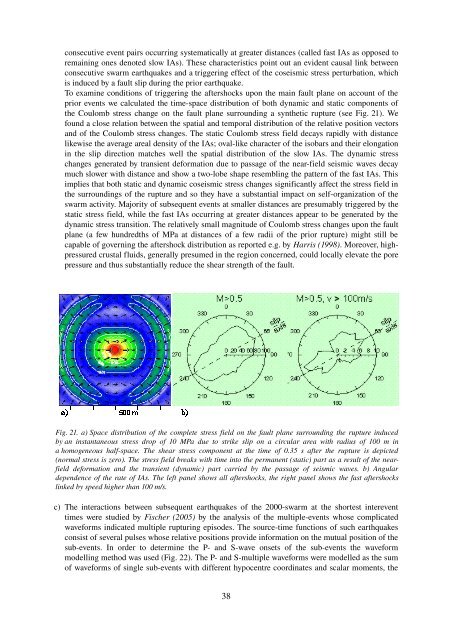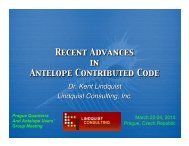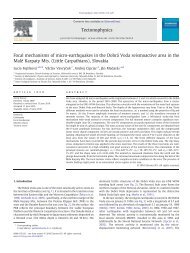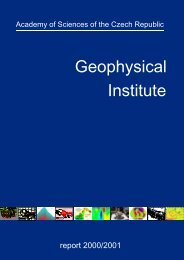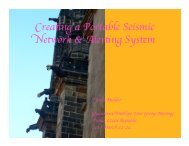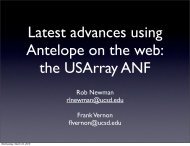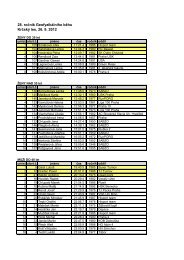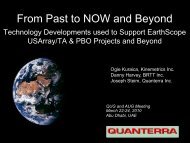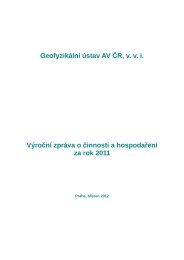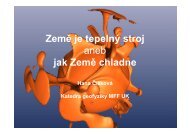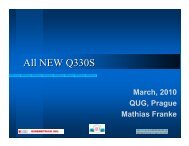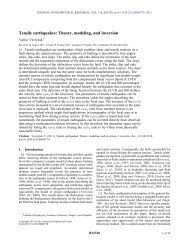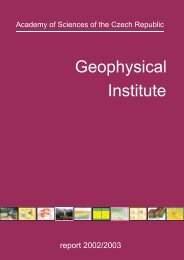Geophysical Institute of the ASCR
Geophysical Institute of the ASCR
Geophysical Institute of the ASCR
Create successful ePaper yourself
Turn your PDF publications into a flip-book with our unique Google optimized e-Paper software.
consecutive event pairs occurring systematically at greater distances (called fast IAs as opposed to<br />
remaining ones denoted slow IAs). These characteristics point out an evident causal link between<br />
consecutive swarm earthquakes and a triggering effect <strong>of</strong> <strong>the</strong> coseismic stress perturbation, which<br />
is induced by a fault slip during <strong>the</strong> prior earthquake.<br />
To examine conditions <strong>of</strong> triggering <strong>the</strong> aftershocks upon <strong>the</strong> main fault plane on account <strong>of</strong> <strong>the</strong><br />
prior events we calculated <strong>the</strong> time-space distribution <strong>of</strong> both dynamic and static components <strong>of</strong><br />
<strong>the</strong> Coulomb stress change on <strong>the</strong> fault plane surrounding a syn<strong>the</strong>tic rupture (see Fig. 21). We<br />
found a close relation between <strong>the</strong> spatial and temporal distribution <strong>of</strong> <strong>the</strong> relative position vectors<br />
and <strong>of</strong> <strong>the</strong> Coulomb stress changes. The static Coulomb stress field decays rapidly with distance<br />
likewise <strong>the</strong> average areal density <strong>of</strong> <strong>the</strong> IAs; oval-like character <strong>of</strong> <strong>the</strong> isobars and <strong>the</strong>ir elongation<br />
in <strong>the</strong> slip direction matches well <strong>the</strong> spatial distribution <strong>of</strong> <strong>the</strong> slow IAs. The dynamic stress<br />
changes generated by transient deformation due to passage <strong>of</strong> <strong>the</strong> near-field seismic waves decay<br />
much slower with distance and show a two-lobe shape resembling <strong>the</strong> pattern <strong>of</strong> <strong>the</strong> fast IAs. This<br />
implies that both static and dynamic coseismic stress changes significantly affect <strong>the</strong> stress field in<br />
<strong>the</strong> surroundings <strong>of</strong> <strong>the</strong> rupture and so <strong>the</strong>y have a substantial impact on self-organization <strong>of</strong> <strong>the</strong><br />
swarm activity. Majority <strong>of</strong> subsequent events at smaller distances are presumably triggered by <strong>the</strong><br />
static stress field, while <strong>the</strong> fast IAs occurring at greater distances appear to be generated by <strong>the</strong><br />
dynamic stress transition. The relatively small magnitude <strong>of</strong> Coulomb stress changes upon <strong>the</strong> fault<br />
plane (a few hundredths <strong>of</strong> MPa at distances <strong>of</strong> a few radii <strong>of</strong> <strong>the</strong> prior rupture) might still be<br />
capable <strong>of</strong> governing <strong>the</strong> aftershock distribution as reported e.g. by Harris (1998). Moreover, highpressured<br />
crustal fluids, generally presumed in <strong>the</strong> region concerned, could locally elevate <strong>the</strong> pore<br />
pressure and thus substantially reduce <strong>the</strong> shear strength <strong>of</strong> <strong>the</strong> fault.<br />
Fig. 21. a) Space distribution <strong>of</strong> <strong>the</strong> complete stress field on <strong>the</strong> fault plane surrounding <strong>the</strong> rupture induced<br />
by an instantaneous stress drop <strong>of</strong> 10 MPa due to strike slip on a circular area with radius <strong>of</strong> 100 m in<br />
a homogeneous half-space. The shear stress component at <strong>the</strong> time <strong>of</strong> 0.35 s after <strong>the</strong> rupture is depicted<br />
(normal stress is zero). The stress field breaks with time into <strong>the</strong> permanent (static) part as a result <strong>of</strong> <strong>the</strong> nearfield<br />
deformation and <strong>the</strong> transient (dynamic) part carried by <strong>the</strong> passage <strong>of</strong> seismic waves. b) Angular<br />
dependence <strong>of</strong> <strong>the</strong> rate <strong>of</strong> IAs. The left panel shows all aftershocks, <strong>the</strong> right panel shows <strong>the</strong> fast aftershocks<br />
linked by speed higher than 100 m/s.<br />
c) The interactions between subsequent earthquakes <strong>of</strong> <strong>the</strong> 2000-swarm at <strong>the</strong> shortest interevent<br />
times were studied by Fischer (2005) by <strong>the</strong> analysis <strong>of</strong> <strong>the</strong> multiple-events whose complicated<br />
waveforms indicated multiple rupturing episodes. The source-time functions <strong>of</strong> such earthquakes<br />
consist <strong>of</strong> several pulses whose relative positions provide information on <strong>the</strong> mutual position <strong>of</strong> <strong>the</strong><br />
sub-events. In order to determine <strong>the</strong> P- and S-wave onsets <strong>of</strong> <strong>the</strong> sub-events <strong>the</strong> waveform<br />
modelling method was used (Fig. 22). The P- and S-multiple waveforms were modelled as <strong>the</strong> sum<br />
<strong>of</strong> waveforms <strong>of</strong> single sub-events with different hypocentre coordinates and scalar moments, <strong>the</strong><br />
38


